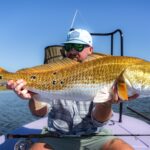
Louisiana Bull Reds Up for Harvest Again: H.B. 604 Must Not Pass
Photo Credit: Carter Abramson | Trevor Johnson Every now and then, we encounter something so
Feature Photo: Osprey in Flight After Catching a Menhaden Fish – Abeselom Zerit
Menhaden are often referred to as the most important fish in the sea, and for good reason. Just about every fish, many marine mammals, and sea birds on the Atlantic coast eat them! Yet, menhaden management is often polarizing, lacking adequate science, and arguably not conservative enough.
ASGA firmly believes in improving the models that inform how many menhaden need to be left in the ecosystem for predators, the methodology for analyzing the Chesapeake Bay at an ecosystem level (and managing the fishery sustainably), developing formal management in the Gulf of Mexico, and advocating for rigorous menhaden science.
Several weeks ago at the Spring ASMFC Meeting, we saw a presentation from Dr. Genny Nesslage from the University of Maryland Center for Environmental Science Chesapeake Biological Laboratory about her work on menhaden overwintering off the New Jersey coast, a phenomenon that fishermen observed for years, yet fisheries science had largely not captured through fishery-independent data. One of the most intriguing aspects was learning how Dr. Nesslage utilized advanced fishing sonar technology to estimate these menhaden schools’ size accurately. While this was the big takeaway, the work also collected important biological data that could inform upcoming menhaden stock assessments in 2025.
“We collected a large number, over three hundred samples, of those scales and otoliths (the ear bones) that we can basically use to count the rings like tree rings to get their ages […] I think it’s a matter of getting the methods down and coming up with some best practices with this variant, informative data that we are able to collect on these older animals that we almost never see in the biological sampling that’s done at ports.
Dr. Nesslage discussing menhaden aging in EP144 of the Guide Post
Menhaden advocates and anglers interested in learning more can tune into the latest episode of The Guide Post Podcast for the full discussion with ASGA’s Will Poston and Dr. Nesslage about this exciting menhaden research and some management commentary – “EP144: Mathematics of Menhanden” – available now on all major podcast platforms.

Photo Credit: Carter Abramson | Trevor Johnson Every now and then, we encounter something so

This past weekend, ASGA proudly sponsored the Dirty Carp Tournament in Louisiana — and no, you didn’t misread that.

After years of data pouring in from The Albie Project, advocacy, persistence, and support from

This morning, the Connecticut Environment Committee held a hearing on House Bill 6248, a bill
We rely on our members and donations to keep fighting for a sustainable tomorrow in marine conservation.
GIVE THE GIFT OF FISHERIES CONSERVATION THIS HOLIDAY SEASON. SHOP ASGA GOODS THAT FUND FISHERIES RESEARCH & ADVOCACY CAMPAIGNS
JOIN ASGA IN CALLING FOR CRITICAL MANAGEMENT ACTION AFTER YEARS OF SPAWN FAILURES & POOR MANAGEMENT.
By using this website, you agree to our use of cookies. We use cookies to provide you with a great experience and to help our website run effectively. To learn more, please review our privacy policy.